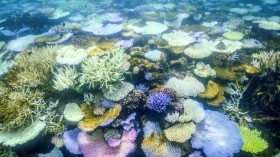Water-rich minerals have been detected on Psyche, the largest metallic asteroid in our solar system.
According to the study, published in The Astronomical Journal, the finding which was detected using NASA Infrared Telescope Facility (IRTF) was surprising because previous observations of psyche did not show evidence for water and/or hydroxyl on its surface.
As reported by Science Daily, Psyche which is thought to be the a residue of a forming planet which was blasted off millions of years ago is situated 186 miles across and is thought to be composed of pure nickel-iron metal.
"We did not expect a metallic asteroid like Psyche to be covered by water and/or hydroxyl," Vishnu Reddy, an assistant professor at the University of Arizona's Lunar and Planetary Laboratory said in a statement. "Metal-rich asteroids like Psyche are thought to have formed under dry conditions without the presence of water or hydroxyl, so we were puzzled by our observations at first."
Space.com notes that hydroxyl exists on Earth, but is very reactive and tends to combine with other compounds.
How did the water-rich minerals get there? Did Psyche suddenly evolved?
As explained by the researchers, it is possible that the minerals were brought in by carbonaceous asteroids that collided with Psyche in the distant past.
"We think that Psyche may not be entirely exposed metallic core," Driss Takir, lead author and scientist at the USGS Astrogeology Science Center in Flagstaff, Arizona said in a press release.
"What we see might instead have been a core-mantle boundary of a differentiated body that was disrupted via impacts. Solar radiation is another mechanism that can produce hydroxyl, which is a molecule consisting of one oxygen atom and one hydrogen atom, by interacting with the surface of Psyche."
Meanwhile, Laszlo Kestay, Director of the USGS Astrogeology Science Center said the discovery highlights how much more we have to learn about asteroids before we can fully understand them.
© 2024 NatureWorldNews.com All rights reserved. Do not reproduce without permission.

![Microplastics Escape Body's Gut to 'Infiltrate' the Brain, Kidneys and Liver [Study]](https://1471793142.rsc.cdn77.org/data/thumbs/full/70195/280/157/50/40/microplastics-escape-bodys-gut-to-infiltrate-the-brain-kidneys-and-liver-study.jpg)



